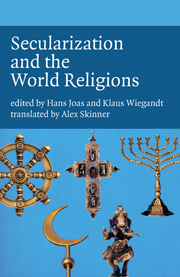Book contents
- Frontmatter
- Contents
- Notes on Contributors
- Foreword
- Society, State and Religion: Their Relationship from the Perspective of the World Religions: An Introduction
- 1 Catholic Christianity
- 2 Protestantism
- 3 The Departure and Return of God: Secularization and Theologization in Judaism
- 4 Islam and Secularization
- 5 Hinduism
- 6 Secularization: Confucianism and Buddhism
- 7 From Hostility through Recognition to Identification: State–Church Models and their Relationship to Freedom of Religion
- 8 ‘Science Doesn't Tremble’: The Secular Natural Sciences and the Modern Feeling for Life
- 9 The Religious Situation in Europe
- 10 The Religious Situation in the USA
- 11 The Religious Situation in East Asia
- 12 The Relevance of the European Model of Secularization in Latin America and Africa
- 13 The Desecularization of the Middle East Conflict: From a Conflict between States to a Conflict between Religious Communities
- Afterword
9 - The Religious Situation in Europe
- Frontmatter
- Contents
- Notes on Contributors
- Foreword
- Society, State and Religion: Their Relationship from the Perspective of the World Religions: An Introduction
- 1 Catholic Christianity
- 2 Protestantism
- 3 The Departure and Return of God: Secularization and Theologization in Judaism
- 4 Islam and Secularization
- 5 Hinduism
- 6 Secularization: Confucianism and Buddhism
- 7 From Hostility through Recognition to Identification: State–Church Models and their Relationship to Freedom of Religion
- 8 ‘Science Doesn't Tremble’: The Secular Natural Sciences and the Modern Feeling for Life
- 9 The Religious Situation in Europe
- 10 The Religious Situation in the USA
- 11 The Religious Situation in East Asia
- 12 The Relevance of the European Model of Secularization in Latin America and Africa
- 13 The Desecularization of the Middle East Conflict: From a Conflict between States to a Conflict between Religious Communities
- Afterword
Summary
This essay is divided into three parts. First, I offer a very general and therefore somewhat superficial overview of the contemporary religious situation in Europe. In the second part, I offer a series of arguments why the paradigm of secularization is not very helpful in trying to explain the complex religious situation in Europe today, and why we need to look at the secularization of Western European societies with new eyes and with new perspectives, which can only come from a more comparative historical and global perspective. Finally, I offer some suggestions as to why the expectation that religion would become increasingly privatized and therefore socially irrelevant has not proven to be correct and why, on the contrary, we are now witnessing the fact that religion is once again becoming an important public issue in Europe.
Overview of the religious situation in Europe
First of all, it is important to emphasize that there is not one single and uniform religious situation in Europe. There are multiple, very diverse and ambiguous religious situations and trends throughout Europe which one should avoid characterizing in simple terms. I can only indicate here some of the most obvious differences. Former East Germany is by far and by any measure the least religious country of all of Europe, followed at a long distance by the Czech Republic and the Scandinavian countries. At the other extreme, Ireland and Poland are by far the most religious countries of Europe with rates comparable to those of the United States.
- Type
- Chapter
- Information
- Secularization and the World Religions , pp. 206 - 228Publisher: Liverpool University PressPrint publication year: 2009
- 6
- Cited by

